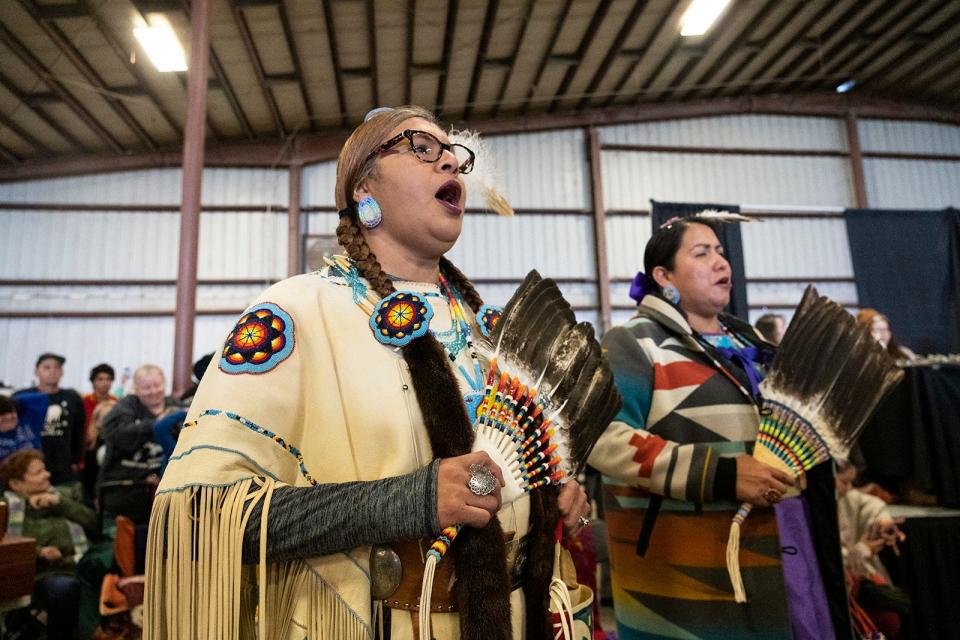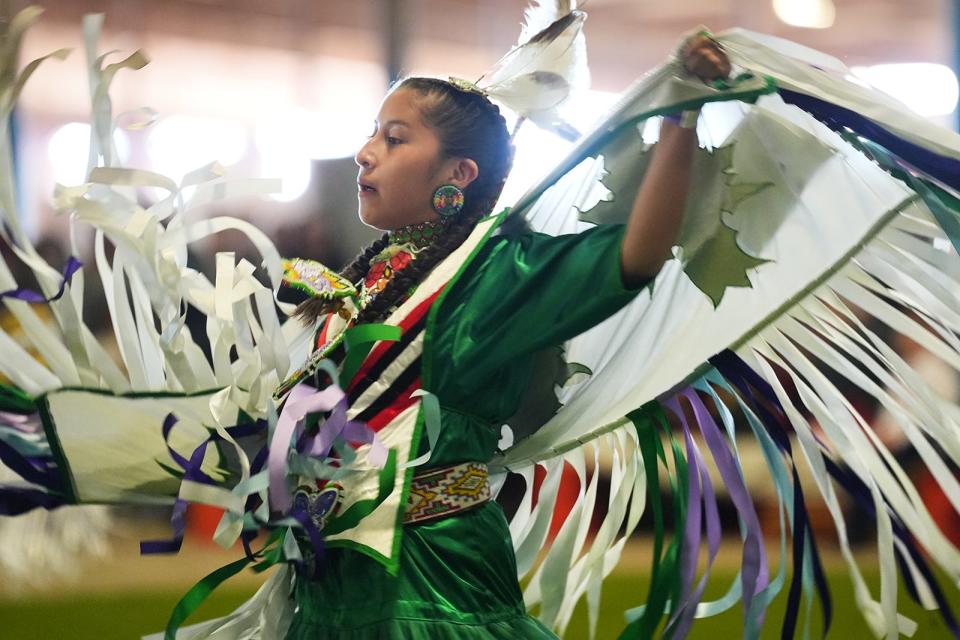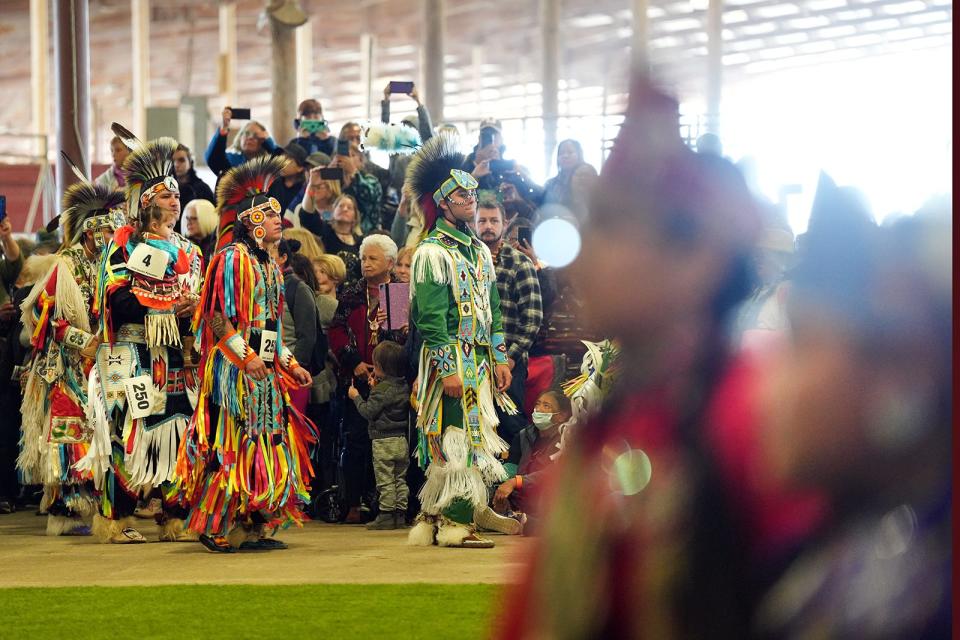'It's just so beautiful': Austin Powwow celebrates Native American heritage, history
The sound of the drum comes first.
Even before entering the Travis County Exposition Center, the powerful rhythm beats against visitors’ ears.
Melanie Sais loves hearing that drum — or, as she calls it, the heartbeat.
“It’s drawing you in,” Sais said. “I can hear that drum as I’m coming to a powwow, and it just brings you in, and it reminds you of home. It centers you.”
The drum played all day Saturday at the Austin Powwow, an annual celebration of Native American history and culture. Local nonprofit Great Promise for American Indians has hosted the event for more than 25 years, featuring food, vendors and dance competitions. Sais, a powwow committee member and Great Promise board member, said thousands of people — both Native and non-Native — attend.
“We encourage everyone in the public to come because we want to share our heritage and our culture with everyone in hopes that it brings awareness about our background and culture to people because there’s a lot of misconceptions about our heritage,” said Sais, who’s from the Standing Rock Lakota Tribe in North Dakota.

If the drum is the heartbeat of the powwow, dance seems to be the heart itself, given life by the strong, steady instrument. A large square of artificial grass served as the dance stage, and attendees crowded near the stage or took to the bleachers to watch.
The powwow presented dance competitions for a variety of categories, including men’s fancy dance, women’s fancy shawl, men’s grass dance and women’s jingle, which features regalia adorned with cone-shaped metals that clink together.
“If you close your eyes and listen to it when they're dancing, it almost sounds like raindrops,” Sais said. “It’s just so beautiful.”
Sais dances both jingle and northern traditional, which differs from southern traditional because of the music and regalia.
“The southern traditional, when they're given their song … it's lower, kind of like a lower pitch sound,” Sais said. “And their regalia is different, their dresses are different, and it's more of the Texas-Oklahoma area, maybe some Arizona, New Mexico. The northern traditional … the song is a little more high pitched, and … our dance is a little more … like a faster step.”
Texas History: What happened to the Native Americans in Texas?
Sais didn’t compete in any dances at the powwow, but she did help braid a fellow dancer’s hair. As she expertly styled Carol Melting Tallow’s long locks, she said her grandmother always told her never to have a stranger do her hair — she didn’t want to receive a bad spirit. Instead, she needed to have a friend, like Melting Tallow, prepare her hair and place a good, loving spirit on her.
“Our hair is our life,” Sais said. “The only time we’re really supposed to cut our hair is if a really close family member passes away. So, when my grandmother died, I cut my hair. I cut it pretty short.”

Melting Tallow, who has an Indian name meaning Eagle Woman, is a champion fancy dancer. She began her professional dance career at 24 years old, and now at 43, she travels to powwows as a competitor and judge.
“Native American dancing or Native Canadian or First Nation dancing, it's always been in our ways of life,” Melting Tallow said. “I just grew up with it with my mother and my father partaking in it, and then I grew up from the Treaty 7 area, meaning that's Alberta, Canada. That's our form of what preserved our culture up north.”
Away from the dance arena were rows of vendors selling dreamcatchers, jewelry, flutes, artwork and other Native artisanry. Many of these items have special meanings and purposes, such as the dreamcatchers, which capture bad dreams.
For first time in 233 years:Native American, Native Alaskan, Native Hawaiian all in U.S. House
Several vendors sold fetishes, which are animals and other figures carved out of stone and shell. Fetishes originated among the Zuni people from New Mexico’s Zuni River valley, and a handful of animal fetishes have special characteristics. The bear is strength and healing, the deer is agility and gentleness, the buffalo is power and abundance, the frog is fertility and renewal, the mole is self-discovery and grounding, and the turtle is longevity and peace.
“I had a couple of friends who wanted to get pregnant,” said Becky Burt, an Anglo trader for Silver Moon Traders. “I said, ‘You want a frog.’ Within six months, there was baby!”
Burt said the Zuni give each of the six directions — north, south, east, west, above and below — an animal. Some of the fetishes are inlaid with turquoise, an important stone in Native American culture because of its connections to the sky, and healing and protection elements. Turquoise could be found in much of the powwow vendors’ jewelry, from earrings to necklaces and bracelets.
A couple of stalls down from Silver Moon Traders were Navajo vendors selling sandpainting, which has roots in healing and ceremonial practices. Most of the sand used in the artwork came from the mountains surrounding the Four Corners, where the corners of Arizona, Colorado, New Mexico and Utah meet.
“We’ll use (sandpainting) in our culture, in the Navajo culture, if there's bad spirits or bad ailments and then a medicine man who uses it in ceremonial purposes,” Ronnie Reeves said. “After he's done with it, he destroys it, so sends all the negativity back into Mother Earth.”
Aside from the dances and vendors, powwows serve as a chance for connection among the Native American community, which Sais said continues to grow.

“As Austin’s growing or Central Texas is growing, we keep finding more and more Native Americans,” Sais said. “It’s awesome to just bring more people into the community that are willing to help and share our culture with other people, too. So, it’s nice; it’s kind of like welcoming a new family member.”
First Native American woman in space:NASA astronaut Nicole Mann becomes first Native American woman in space, hoping to inspire future generations
Growing the community and sharing the culture is a year-round mission for Great Promise for American Indians, which offers dance performances, storytelling, beading lessons and more. But the organization’s powwow holds a special place in Sais’s heart — and the hearts of many others.
“For me, it means a lot because … just knowing how my grandparents lived and everything … not being really able to share their culture … you couldn't really share it out in your community,” Sais said.
“And here, it's just — to me — it's just amazing that so many people are so interested, and they have so many questions, and they're just so in awe about what we do,” Sais said. “And I just think that for us, (November being) Native American Heritage Month (means) we can put more emphasis on, ‘Hey, we're still here. We're still trying to share our culture, and we want you to be a part of it.’”
This article originally appeared on Austin American-Statesman: A celebration of Native American Heritage Month at Austin Powwow

